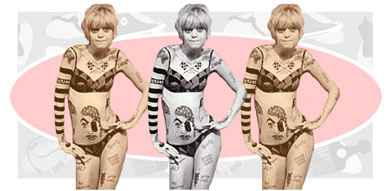Body paint

Fashion Synopsis
Demi Moore made headlines in 1992 when she appeared on the cover of Vanity Fair in a painted-on tuxedo (and nothing else). But Demi didn't corner the market on body painting, and she certainly wasn't the first to shock the world with a little bit of paint.
Painting of the face and body became another psychedelic trip of the 60’s. Mod model Twiggy added a famous flower eye to her look, and suddenly everyone wanted to use the body as a canvas. This was no slapdash fingerpainting, however—Twiggy’s flower eye was a careful artistic work, with painted petals and false eyelashes framing her doe-eyes. Makeup as an artistic tool changed the face of cosmetics: makeup wasn’t just to prettify, it was to electrify.
The hippies (as is their wont) went a step further, trading in their clothes for body paint. Flowers, peace symbols, smiley faces: bodies became a living canvas for the art of the new groovy lifestyle. Stores like London's Lady Jayne would hand paint a one-of-a-kind dress or necklace on customers as they waited. No more spending all day in the fitting rooms and walking out unhappy. Artists were on hand to create your very own fashion statement, tailored to you.
Every day your wardrobe could change, as your clothes dissolved with a washcloth and bar of soap. A forerunner of the tattoo, body paint allowed you to share your message and joy with the world. While body paint would never take the place of clothes in conservative circles, painting became an exciting accessory to already psychedelic fashions.
All of this various and sundry painting led to an interesting practical dilemma: Nudity will get you arrested for indecent exposure, but what if you had a dress or suit painted on? Is that still considered nudity?
